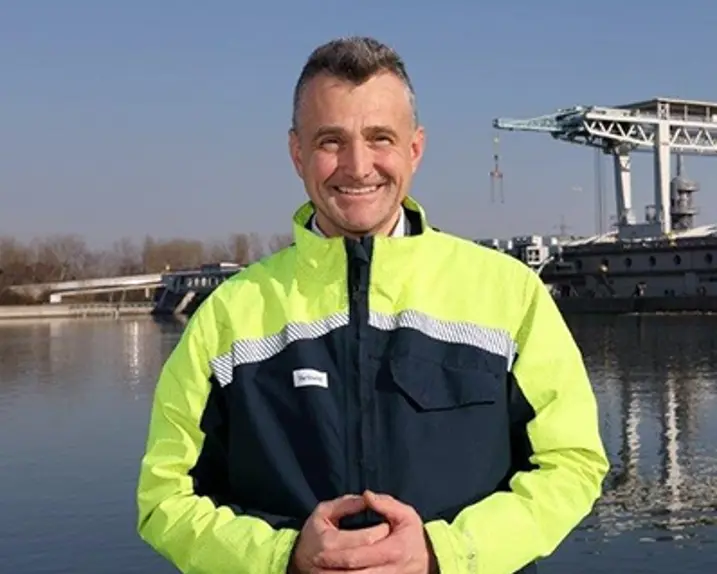Austria’s most advanced workboat in operation on the Danube
As one of the largest fleet operators on the Danube, VERBUND is investing in upgrading its vessels. The newly commissioned “DONAU 1”, a multifunctional workboat, is now operational. The custom-built vessel incorporates European engineering expertise, tailored to the complex technical requirements of hydropower operations. Designed for maximum energy efficiency, it features fuel-saving technology and is preconfigured for retrofitting with batteries.
Governor Johanna Mikl-Leitner assumed the role of godmother at the christening ceremony for the Danube’s most advanced service vessel. “The Danube is a lifeline for Lower Austria, serving as a transport artery, a natural habitat, a tourist attraction and a key energy supplier. The new ‘DONAU 1’ workboat is a real powerhouse – modern, versatile, and fully equipped for its mission. May it serve the Danube safely and successfully for many years to come!”
Achim Kaspar, a member of VERBUND AG’s Executive Board and responsible for hydropower within the Group, emphasised the strategic importance of the vessel: “There is still far too little awareness of how complex the operation of hydropower plants really is. Here on the Danube, Europe’s largest river, our responsibilities go beyond electricity generation. We also maintain navigable channels in our impoundments, remove sediment deposits, carry out riverbank restoration projects and bring in our own materials to stabilise the riverbed. The new workboat will play an important role in supporting these activities.”
Michael Amerer, Managing Director of VERBUND Hydro Power GmbH, welcomed the milestone: “The christening of the new vessel represents another major step forward in the future of our company. The majority of our vessels date back to the time when our hydropower plants were built. The DONAU 1 now gives us Austria’s most advanced service vessel. It combines the specific capabilities of four different service vessels – such as icebreaking – into a single, multifunctional combination vessel.”
Karl Heinz Gruber, Managing Director of VERBUND Hydro Power GmbH, echoed the enthusiasm for this trend-setting technology: “The investment was urgently needed, but marks only the beginning of our fleet modernisation and greening project. In addition to the DONAU 1, two modern split barges with a capacity of approx. 600 m³ each are currently under construction and will be equipped with large new excavators. We have also just launched an innovative project to replace the diesel-electric drive with a battery drive to enable an additional reduction in CO2 emissions.”
A versatile powerhouse
The “DONAU 1” is Austria’s most advanced multifunctional work vessel. With a diesel-electric propulsion system delivering more than 1,800 kW, it can power not only its own onboard systems and drives, but also numerous other large-scale external electrical consumers, either on board or on other vessels. The “DONAU 1” therefore effectively functions as a floating power plant.
Measuring 40 m in length and 11.45 m width, and equipped with three high-capacity thrusters, the DONAU 1 can deliver up to 26.5 tonnes of pushing force capable of moving pusher barge convoys with a gross mass of up to 6,500 tonnes. The hull was manufactured in Romania and then transported via the Danube, the Main-Danube Canal, the Main and the Rhine to the vicinity of Rotterdam, where the ship was equipped with the necessary propulsion drives and technology. The vessel also provides space for a series of 20 containers for battery retrofitting to enable fully electrical operation or to power other vessels. The total investment came to around EUR 10 million.
VERBUND’s fleet on the Danube
With over 30 large utility vessels, VERBUND operates one of the largest fleets on the Danube. The main port is located in Ybbs, where most of VERBUND’s vessels are based. The fleet’s largest vessel in terms of size is a 200-tonne floating crane, capable of lifting even the heaviest machine parts. Dredgers, transport barges, icebreakers, survey boats and various small vessels are in constant use throughout the warmer months.
